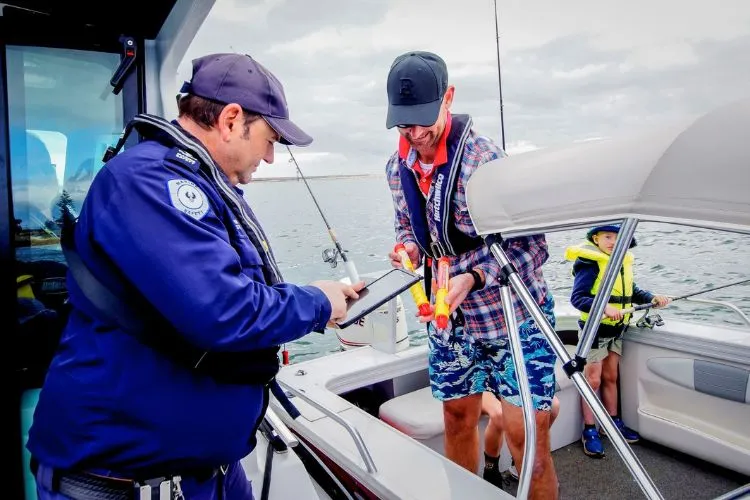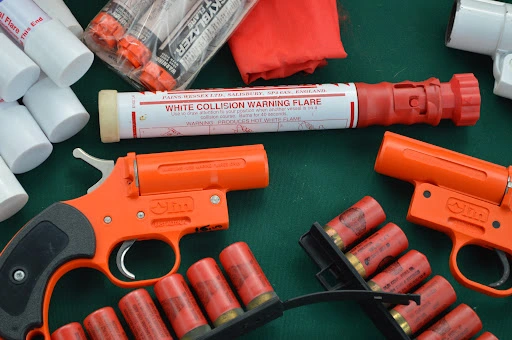Marine flares are essential for safety on the water, providing a vital method of signaling during emergencies.
While they can be lifesavers, improper disposal of these items can lead to environmental harm and legal repercussions.
This guide will arm you with the necessary knowledge on how to dispose of marine flares safely and in accordance with the law.

Understanding Marine Flares
Marine flares are used to signal distress and location to passing ships and rescue services in case of an emergency at sea. They can be pyrotechnic, which produce a bright light after ignition, or non-pyrotechnic, such as electronic flares. Both types have a designated lifespan and must be disposed of after expiration or use.
Legal Requirements for Disposal
The legal aspects of marine flare disposal are not to be overlooked. There are stringent regulations in place to ensure the safe handling and disposal of these hazardous items. Failing to comply can result in penalties. It is crucial to understand and observe these requirements.
How To Dispose Of Marine Flares?
Before disposing of marine flares, it is important to check with local authorities on specific regulations. Ensure the flares are no longer usable and are handled with care to prevent accidental ignition.
Step-by-Step Disposal Guide
For Pyrotechnic Flares
These flares contain chemicals that can be dangerous if not handled correctly. Often, marine supply stores or local hazardous waste facilities are equipped to take them. Short-circuiting pyrotechnic flares is strictly discouraged, as it can lead to harmful consequences.
For Non-Pyrotechnic Flares
Electronic flares can usually be recycled, but check whether special steps are required due to battery components or other hazardous materials. It may necessitate removing certain parts before recycling.
Locating Disposal Facilities
Finding a place to dispose of marine flares is critical. Contact local coast guard offices, marine patrols, or search online for designated disposal facilities near you.
Environmental Impact of Incorrect Disposal
The improper disposal of marine flares can lead to significant environmental consequences, affecting both terrestrial and aquatic ecosystems.
When disposed of incorrectly, the chemical components of pyrotechnic flares, such as potassium perchlorate or strontium nitrate, can leach into the soil and water systems.
This contamination can severely alter the pH of the water and soil, making the environments toxic for plant life and aquatic organisms.
The introduction of such toxic substances can lead to diminished biodiversity and the disruption of delicate ecological balances.

In addition to soil and water pollution, incorrect disposal of flares can increase the risk of wildfires, especially in dry, susceptible regions.
The accidental ignition of a flare can quickly lead to a large-scale environmental disaster, destroying habitats and endangering wildlife. Moreover, such fires release pollutants into the air, contributing to air quality degradation and posing health risks to humans and animals alike.
Marine life specifically suffers when flares are discarded in bodies of water. Chemicals can harm fish and other marine species, either through direct contact or through the buildup of toxins in the food chain.
This not only affects marine organisms but can also impact human communities reliant on these ecosystems for food and economic activities.
Tips for Reducing Marine Flare Waste
Minimizing marine flare waste not only contributes to environmental protection but also promotes safety and cost-effectiveness for boaters. Proper storage plays a pivotal role in extending the life of flares.
Keeping flares in a dry, cool, and dark environment prevents moisture exposure and degradation, thereby maintaining their functionality for longer periods. Utilizing waterproof containers can significantly enhance their longevity and reliability when needed.
Another eco-friendly approach is the sharing of unused, unexpired flares among the boating community. This practice can ensure that flares are used to their full potential before expiration, reducing waste.
However, it’s crucial to ensure that such sharing complies with local regulations and safety standards to avoid legal complications or safety hazards.
Adopting reusable signal devices is an innovative and sustainable alternative to traditional flares. Devices such as electronic flare lights, although initially more expensive, can be used multiple times, offering a long-term solution that diminishes the need for frequent replacements and disposals.
This shift not only lessens environmental impact but also encourages a more sustainable approach to maritime safety practices.
By implementing these strategies, boaters can significantly reduce marine flare waste, contributing to environmental preservation and fostering a culture of sustainability and responsibility within the marine community.
Safety Tips When Handling Marine Flares
To mitigate safety risks associated with marine flares, it is crucial to handle them with care throughout their lifecycle, including transport and storage prior to disposal.
When transporting flares, secure them in a rigid, fire-resistant container to prevent accidental ignition from friction or impact. Keep the container away from heat sources, open flames, and electrical equipment to reduce the risk of an unintentional flare-up.

For storing flares, choose a dry, well-ventilated area that is isolated from living spaces and out of reach of children. Ensure flares are easily accessible in case of an emergency but also secure from inadvertent access that could lead to misuse.
In the event a flare ignites unexpectedly, remain calm and handle the situation with caution. If possible, use the flare according to its intended purpose in a safe, open area. Avoid pointing it at any person or flammable material.
If using the flare isn’t feasible, place it in a non-combustible area where it can burn out without causing harm. Immediately contact local authorities for assistance if you cannot control the situation safely.
By adhering to these safety tips, boaters can avoid accidents and ensure that flares are safely managed until proper disposal.
Frequently Asked Questions (FAQs)
Can I Dispose of Marine Flares in Regular Trash?
You should never dispose of marine flares in your regular trash. The hazardous materials in flares can cause fires and pose a threat to waste management workers.
What if My Marine Flares are Expired?
Expired marine flares should be treated with the same care as unused ones and disposed of according to local laws and guidelines.
Are There Any Disposal Programs or Events?
Some areas offer disposal programs or events, particularly around boating season. Keep an eye out for information from local marine authorities.
How Often Should Marine Flares be Replaced?
Marine flares generally have a shelf life of three to four years. However, always reference the manufacturer’s recommendations for specific products.
Conclusion:
The safe and legal disposal of marine flares is a responsibility that all boaters and marine enthusiasts must take seriously.
By understanding the types of flares, the legal requirements for disposal, and the proper methods to do so, we can ensure the safety of individuals and the preservation of our environment.
Stay informed and prepared, and always prioritize the correct disposal of marine flares.


